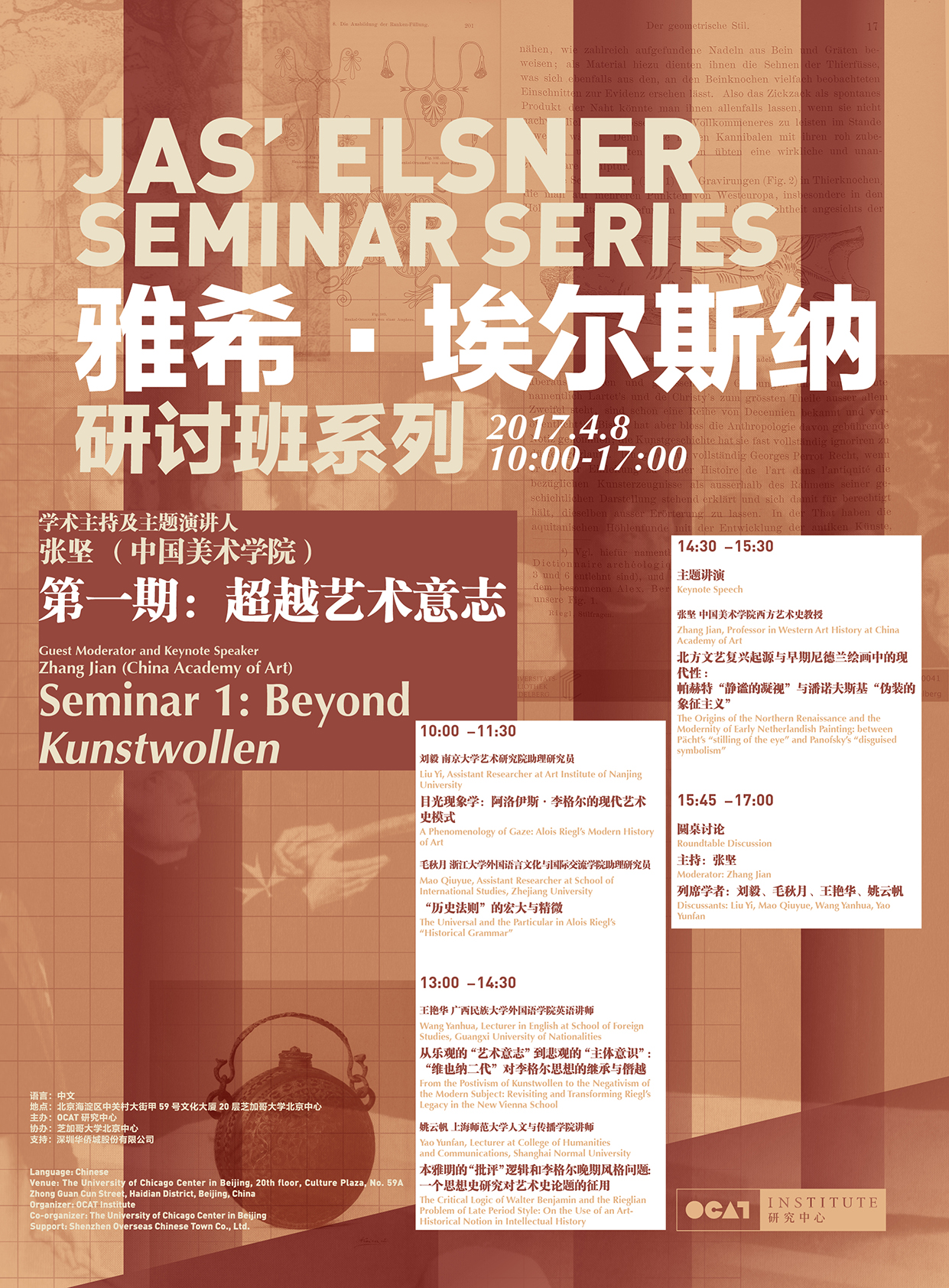Jas’ Elsner Seminar One: Beyond Kunstwollen
- When:
- Saturday, April 8, 2017 10:00 am - 5:00 pm
- Where:
-
The University of Chicago Center in Beijing
20th floor, Culture Plaza
No. 59A Zhong Guan Cun Street
Haidian District Beijing 100872 - Description:
-
Time: April 8, 2017, 10am-5pm
Organizer: OCAT Institute
Co-organizer: The University of Chicago Center in Beijing
Venue: The University of Chicago Center in Beijing, 20th floor, Culture Plaza, No. 59A Zhong Guan Cun Street, Haidian District, Beijing
Support: Shenzhen Overseas Chinese Town Co., Ltd.
Guest Moderator and Keynote Speaker: Zhang Jian (China Academy of Art)
The several generations of art historians from the Vienna School of Art History, from the end of 19th century through the postwar period, gradually transformed Alois Riegl’s formal analysis into the method of Strukturanalyze that sought to excavate the structure of intellectual and social experience encapsulated within the visual and formal structure of artifacts. Postwar attacks on the second generation of Vienna School, however, specifically targeted the hints of nationalist ideology either inherent in or later imposed onto the writing of art history, notably in the case of the Nazi art historian Hans Sedlmayr.
The complexity of Riegl’s method not only resides in his relativistic attack on preconceived hierarchies of western and non-western tradition, fine arts and crafts, stylistic progression and decline, which allows him to construct a sweeping history of world art and ornament. It could also be discerned through the variegated strands of reception that Riegl’s scholarship enjoyed among the pioneering practitioners of humanities and critical theory at the beginning of the century: from the appraisal and resonance with Soviet literary formalism to the positive reception and reflection on Riegl by several key sociologists and political thinkers of the Frankfurt School. The Viennese discourse on formalist aesthetics and visual psychology soon inspired parallel discussions on contemporary social and intellectual crisis and the very condition of cultural modernity itself. After the ideological faction of the postwar period, the divergence from and the problematization of iconology in the 1980s and 1990s coincided with trails of centenary commemorations, bringing a reinvigorated thinking on Vienna School to the forefront of art historiography. These revivals also resonated with forceful challenges posed by structuralism and post-structuralism to the discipline.
This seminar starts with the theoretical background of the 19th century in which Riegl’s idea took shape, and gradually moves on to the reflections and critiques on the Rieglian model by scholars both within and beyond the discipline of art history. As an attempt at “rigorous historicization”, the seminar zeroes in on concrete historiographic cases, with the first section devoted to the examination of several key Rieglian concepts and the second section and keynote speech to the discussion of two key members of the New Vienna School (Hans Sedlmayr and Otto Pächt). Meanwhile, the juxtaposition of Hans Sedlmayr and Walter Benjamin in the second section seeks to move beyond facile ideological denigration and critically rethink Vienna School’s postwar “fall from grace”. The cases of Sedlmayr and Benjamin, presented here, allow us to peer through the complex landscape of two divergent politics of scholarship and methods, which, before the emergence of ideological and methodological divide, partially met on a dangerous common ground.
Beyond Kunstwollen holds a steady focus on the theoretical contribution of the Vienna School of art history, where close readings of Alois Riegl and other members is joined with discussions on the convergence and collision between formalist art history, Kulturwissenschaft, cultural modernity, critical theory and philosophy. It seeks to retrace the complex facets of Riegl’s art history through the manifold history of its reception, in the hope of excavating the relevance of the pioneering art historian for contemporary art history.
PROGRAM
Morning Session
10:00-10:15
Welcome and Introduction
10:15-10:45
A Phenomenology of Gaze: Alois Riegl’s Modern History of Art
Dr. Liu Yi, Nanjing University
10:45-11:15
The Universal and the Particular in Alois Riegl’s “Historical Grammar”
Dr. Mao Qiuyue, Zhejiang University
11:15-11:45 Discussion
11:45-13:00 Lunch
Afternoon Session
13:00-13:30
From the Positivism of Kunstwollen to the Negativism of the Modern Subject: Revisiting and Transforming Riegl’s Legacy in the New Vienna School
Dr. Wang Yanhua, Guangxi University of Nationalities
13:30-14:00
The Critical Logic of Walter Benjamin and the Rieglian Problem of Late Period Style: On the Use of an Art-Historical Notion in Intellectual History
Dr. Yao Yunfan, Shanghai Normal University
14:00-14:30 Discussion
14:30-15:30
Keynote Speech
The Origins of the Northern Renaissance and the Modernity of Early Netherlandish Painting: between Pächt’s “stilling of the eye” and Panofsky’s “disguised symbolism”
Prof. Zhang Jian, China Academy of Art
15:30-15:45 Coffee Break
15:45-17:00 Roundtable Discussion
Moderator: Prof. Zhang Jian
Discussants: Dr. Liu Yi, Dr. Mao Qiuyue, Dr. Wang Yanhua, Dr. Yao Yunfan
雅希∙埃尔斯纳研讨班第一期
超越艺术意志
时间:2017年4月8日 10:00—17:00
地点:北京海淀区中关村大街甲59号文化大厦20层芝加哥大学北京中心
主办:OCAT研究中心
协办:芝加哥大学北京中心
支持:深圳华侨城股份有限公司
学术主持及主题演讲人:张坚 (中国美术学院)
维也纳学派从十九世纪末起一直延续到上世纪二战后,其几代人将李格尔的形式分析慢慢演化为对视觉结构、思想结构和社会结构之考古的结构分析。但因为风格分析中含有的诸多民族主义倾向,第二代维也纳学派在二战后饱受意识形态上的批判——尤其是以泽德尔迈尔为首的纳粹学者。同时,海外对维也纳学派的认识也长期受到李格尔早期研究和潘诺夫斯基与泽德尔迈尔于1920年代对“艺术意志”这一概念的论争的影响,无法越过“艺术意志”去挖掘李格尔艺术史写作中极为复杂的理论图景。
这种图景的复杂性不仅体现在李格尔对西方与非西方、艺术与手工艺、激进时期与衰落时期等传统审美等级和概念对立的摒弃与驳斥,以此构建起一个历史和地理跨度巨大的艺术与装饰历史。它也同时体现在西方人文学科理论对李格尔纷繁的接受历史中:从与前苏联形式主义文学理论的隔空对话到法兰克福学派和多位重要社会学和政治学家对李格尔等人理论的积极接受和反思,艺术史内部提出的形式美学和观者心理等议题立刻被纳入到对社会形态、思想形态和文化现代性的转变的探讨中去。在二战的意识形态批判过后,八九十年代对图像学的叛离和诸多百年周年纪念都带来了维也纳学派的复兴和反思,这直接与结构主义和后结构主义对艺术史的冲击与渗透相关联 。
本次研讨从19世纪末李格尔自身的理论土壤出发,并逐渐将讨论聚焦于1920和30年代学科内外对李格尔艺术史观念的多方反思及批判。作为一次历史语境化书写的尝试,这次研讨班的视角集中于微观具体的学科案例,在对李格尔多部著作中核心概念的分析之后,勾勒国内尚待认识的二位新维也纳学派学者(泽德尔迈尔、帕赫特)。同时,下半场研讨中泽德尔迈尔与本雅明的并置企图绕开轻易的意识形态批判,重新审视维也纳学派中被认为“误入歧途”的部分。这条“歧途”中存在现代主义与反现代主义之间辩证性的对抗与内在张力,在80年代起的反思背景下,其与战后拒绝了现象学的实证主义艺术史之间的历史抗衡和互不言明的借鉴,以及两者方法理论各自的利弊才逐渐明晰起来。这两个案例也将为我们重审艺术史写作中学者政治立场与其学理研究和方法论之间的复杂关系提供有益的参照。
会议将紧扣维也纳学派的理论语境,在仔细梳理其核心人物李格尔的理论和研究的同时,探讨德国形式主义艺术史与欧洲文化科学、现代社会、批判理论整体的碰撞和交汇。拒绝将形式主义或形式美学简化为对形式和风格的编年式排列,且试图超越对李格尔以“艺术意志”为主导的解读,本次研讨企图通过维也纳学派内外的谱系发展折射出一个面向更为复杂、历史接受脉络更为多元的李格尔,以此探讨这位堪称艺术史最重要的先驱学者对当代美术史的意义。
研讨班流程
上午10:00—11:45
发言人:刘毅 (南京大学艺术研究院助理研究员)
发言题目:目光现象学:阿洛伊斯∙李格尔的现代艺术史模式
发言人:毛秋月 (浙江大学外国语言文化与国际交流学院博士后研究员)
发言题目:“历史法则”的宏大与精微
下午1:00—2:30
发言人:王艳华 (广西民族大学外国语学院英语讲师)
发言题目:从乐观的“艺术意志”到悲观的“主体意识”:“维也纳二代”对李格尔思想的继承与僭越
发言人:姚云帆 (上海师范大学人文与传播学院讲师)
发言题目:本雅明的“批评”逻辑和李格尔晚期风格问题:一个思想史研究对艺术史论题的征用
下午2:30—3:30
主题讲演
张坚 (中国美术学院艺术史教授)
北方文艺复兴起源与早期尼德兰绘画中的现代性: 帕赫特“静谧的凝视”与潘诺夫斯基“伪装的象征主义”
下午3:45—5:00
圆桌讨论
主持:张坚
列席学者:刘毅、毛秋月、王艳华、姚云帆
发言人简介
刘毅,1985年生于天津,2016年毕业于南京大学,获博士学位,博士论文课题为《艺术意志与观者:李格尔的艺术史论研究》。现为南京大学艺术研究院助理研究员。研究方向为西方艺术史论,视觉文化与文化创意产业。发表论文10余篇,著作1部,参与编写文集1部。
毛秋月,浙江大学传媒学院美学所哲学博士,现为浙江大学外国语言文化与国际交流学院博士后。研究方向为西方现当代艺术理论批评。论文与译文发表于《美术研究》《读书》《文艺理论研究》《新美术》等杂志。译有《重构抽象表现主义》、《中国当代艺术的国际出场》等书。
王艳华,南京大学艺术史博士,广西民族大学外语学院英语教师,主要研究维也纳艺术史学派,博士论文《泽德尔迈尔艺术史论研究》;1981年5月出生,辽宁大连人,2007年大连外国语大学英语学院文学硕士;2015年南京大学艺术研究院艺术学博士毕业。2014年伦敦大学金史密斯学院访问学者,赴伦敦、瑞典斯德哥尔摩、新加坡、台湾、首尔(2016,ICA,20届世界美学大会)等参加国际会议,访问瓦尔堡研究院、瑞典皇家人文、历史及考古学院、台湾艺术大学、台湾文藻外语学院、首尔大学等大学和学术机构。即将出版的译著有《中心的丧失》(汉斯∙泽德尔迈尔),《当代美国生态诗学》(伦纳德∙西格杰),专著一部,论文若干篇,艺术策展项目若干。
姚云帆,江苏常州人,北京外国语大学外国文学研究所博士,上海师范大学比较文学与世界文学研究所讲师,主要研究方向为当代西方文论和文化理论,研究范围涉及本雅明、福柯和阿甘本。在国内数家期刊发表过几篇文章。
主题演讲人
张坚,中国美术学院西方艺术史教授 ,博士生导师,图书馆馆长。研究方向:西方现代美术史、西方近现代艺术史和批评理论、中国现当代美术创作思想研究。出版著作:《康定斯基和马尔克》、《马奈、莫奈和雷诺阿》、《伦勃朗、哈尔斯和维米尔》、《视觉艺术形式的生命》、《西方现代美术史》和《走向人文和批判的西方艺术史学》,出版译著:沃林格《哥特形式论》、康拉德∙菲德勒,《论视觉艺术作品的判断》、 沃尔夫林《意大利与德意志的形式感》、休温∙巴内特《艺术写作:简明指南》以及N.N.霍奇《艺术的故事》等。
